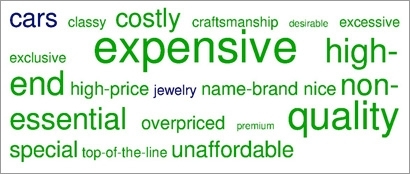Commentary
Luxury Through The Eyes Of The Affluents
- by Bob Shullman , Columnist, January 7, 2015
As we kick-off 2015 in a currently improving U. S. economy, based on a number of factors (e.g., falling unemployment, very low interest rates, rising stock markets, the highest level of consumer confidence in years, and especially the dramatic drop in oil and gasoline prices that have deposited billions of dollars of incremental, disposable income into consumers’ wallets), we envision more consumers (especially the affluent) increasing their shopping for luxury products and services. This comes with one caveat: that no negative economic news or other substantive negative event occurs during the year that impacts consumers’ confidence levels.
Based on our ongoing work in the luxury, affluence and wealth markets, we thought it made sense to ask our survey respondents to describe in their own words what they currently think about when they read, see, or hear the word “luxury.” Why? It’s our point of view based on years of conversing with and surveying consumers that luxury is truly in the eyes of the consumers. And because the affluent marketplace (that we define as adults who live in households with household incomes of $75,000 or more -- about 100 million of them) are the largest market segment that buys luxury products and services, it would be meaningful for marketers and their agencies to understand how consumers currently think about “luxury” as the economy starts really recovering. Additionally, after we asked consumers to describe luxury in their own words, we then asked them to tell us what is the number one luxury brand in the world.
advertisement
advertisement
So what’s luxury through the eyes of affluent consumers? More than 90 different themes emerged from our review of their descriptions. The following word cloud displays the top 20.
Affluents’ Descriptions of Luxury

Notably, two of the top 20 themes affluents described as “luxury” are products (cars and jewelry -- blue in color), while the other 18 (green in color) are either nouns or adjectives. Depending on one’s point of view, some of these 20 themes are positives while others are negatives and some are neutral in tone. The number one luxury theme according to affluents is “expensive” followed by “quality.”
When we then tallied the brands that consumers listed as their #1 luxury brands, again the count was about 90. The following word cloud displays the affluents’ top 20 luxury brands in the world.
Affluents’ Top 20 Luxury Brands in The World

These top 20 luxury brands fall into three different luxury categories: automotive, (blue), luxury goods (green), and watches (yellow). Automotive (which was one of the two product themes that affluents described as “luxury” in the prior word cloud) accounted for ten of the top 20 brands, while luxury goods took up nine positions and watches the remaining one. And at the top of the list is Rolls Royce, the #1 luxury brand among all affluent consumers. Notably, most of these 20 brands have been in the luxury marketplace for a good number of years and are not American brands. Finally, three are relatively new: Tesla (started up in 2003), Lexus (introduced in 1989) and Ralph Lauren who started selling Polo ties in 1967. As for those who didn’t make it into the top 20, 2015 will be a year of considerable opportunity, and a challenge for those marketers and their agencies to break through.



This is an interesting attempt to determine how the affluent define "luxury". It seems a $75,000 threshold for the definition of affluence is pretty low. Especially if that is a household in New York or other major metro area. Households at that level of income in NYC would probably have a much different definition of what is "expensive" (one of the major adjectives for defining luxury) than a household with $200,000 income in Dallas. This in turn would result in big differences in the definition of luxury and the identification of luxury brands.
We have made 2 attempts to see how the truly affluent define luxury in an objective, quantifiable way. Neither attempt was totally successful. One interesting and important reason is that many of the affluent are not familiar with the price points of true luxury products and brands.